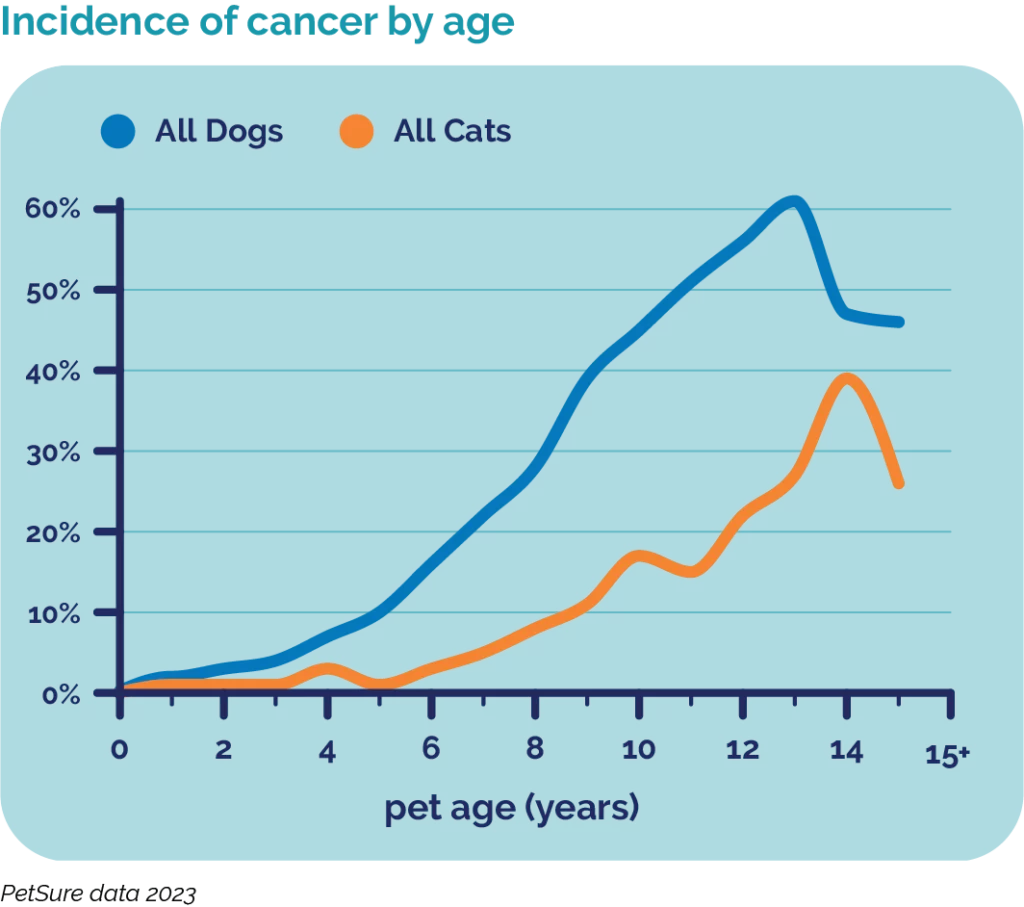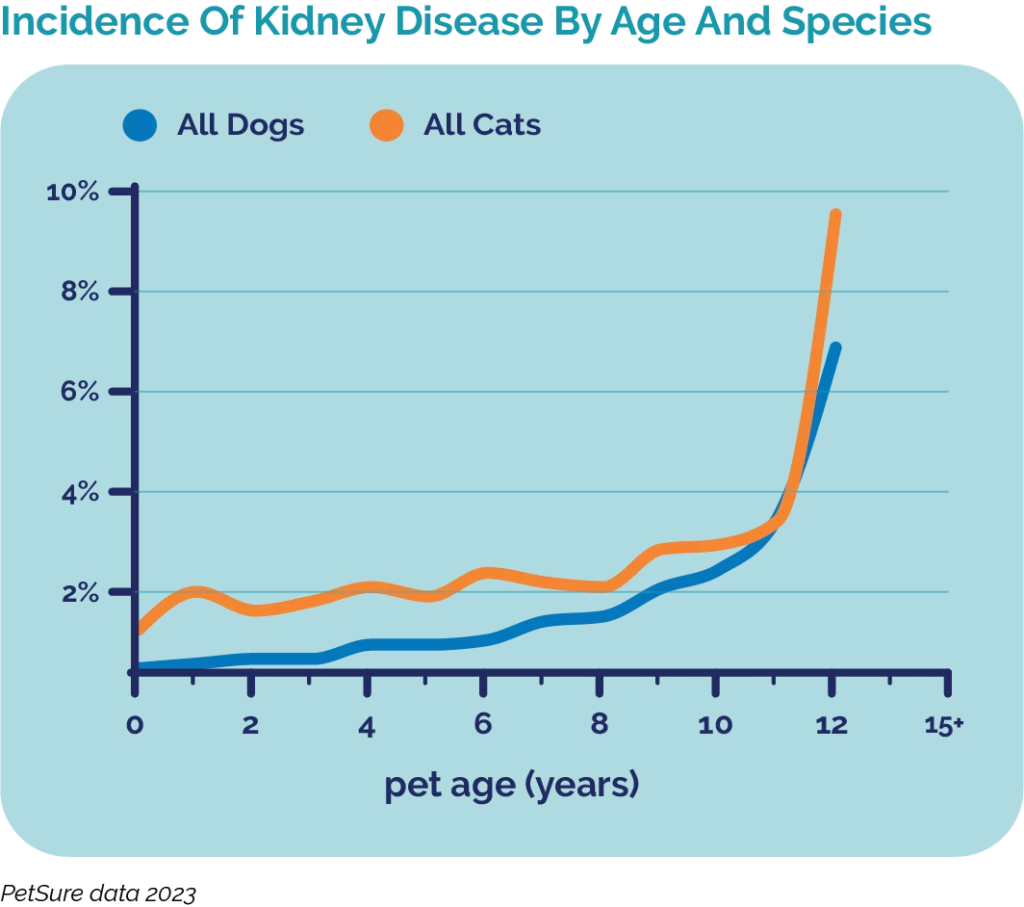At each life stage, a pet’s life expectancy, or the likelihood of them living another 5, 10 or 15 years reduces. However, even at age 8 or 10, there is still a ~65% chance that your dog may live another 5 years^, and a ~20% chance that your cat could live another 10 years^.
The following charts illustrate the likelihood of how many years a pet is expected to live into the future, based on their current age.


^Mortality rates estimated using PetSure internal data 2016 – 2023 (2023 data used in final selection). Where appropriate comparison to relevant industry studies used to validate trends
Understanding and managing common health conditions
As our beloved pets enter their golden years, their health needs evolve significantly. Understanding the common health issues pets face, and the associated treatment costs is crucial. While the emotional bond with pets brings immense joy and benefits to humans, it’s important to be prepared for the challenges that aging can bring to our furry companions.
We covered the top three conditions for older age pets in our Pet Health Monitor 2024, and below we reveal the top 10 health conditions for dogs and cats aged 8+ years*. Interestingly, PetSure observes an increase in pets presenting for clinical signs as they get older, including lethargy and reduced appetite, which are common signs across the chronic conditions listed below.
Top 10 health conditions in pets aged 8+years
| Dogs | Cats |
|---|---|
| Skin infection/allergy | Gastrointestinal disease |
| Arthritis | Arthritis |
| Cancer/tumours | Kidney disease |
| Skin lumps and bumps | Accident/trauma |
| Gastrointestinal disease | Skin infection/allergy |
| Ear condition | Thyroid disease |
| Heart condition | Cancer/tumours |
| Muscle/skeletal condition | Respiratory tract condition |
| Eye condition | Heart condition |
| Cruciate disease | Eye condition |
| Accident – tissue damage/fracture | Ear condition |
How can I support my ageing pet?
From mobility changes to sensory decline, there are many lifestyle changes and health challenges experienced by senior pets. As a pet parent, you can prioritise your pet’s health and comfort during their twilight years by:
Scheduling regular vet check-ups:
Ideally, twice a year for senior pets.
Providing age-appropriate nutrition:
Consider foods rich in joint supplements, such as glucosamine and omega-3 fatty acids, to support mobility and cognitive function.
Look out for telltale signs:
Reduced appetite, progressive weight loss, increased thirst, increased urine production, changes in movement, could all be signs that your elderly pet is not feeling their best, and these could also be early signs of illness.
Weight management:
Weigh pets every 2 weeks and adjust their diet and exercise routine as needed to prevent obesity, which can exacerbate joint problems and other health issues. Consult with your vet for guidance on portion control and appropriate exercise for your senior pet’s condition as you may want to avoid high impact activity. Regular weighing of your pet may help you to pick up weight gain or weight loss from an early stage.
Providing a comfortable home environment: Provide soft bedding and easy access to food, water and litter boxes. Consider installing ramps or steps to help them navigate stairs or furniture more easily, especially if they have mobility issues.

Chronic conditions in ageing pets
Chronic conditions are a significant issue for older pets due to their weakened immune system, degenerative changes, and slower healing processes. Managing multiple chronic illnesses simultaneously can be complex and costly over time, and these conditions significantly impact a pet’s quality of life. Below we explore 5 of these conditions in more detail.
Arthritis (dogs and cats)
Arthritis is the second most common health condition for animals aged 8+ years. This degenerative joint disease causes pain, stiffness and decreased mobility, with symptoms generally worsening during the winter months.
Prevalence and susceptibility
The prevalence of arthritis is 40% in both dogs and cats1. Our data* indicates that while dogs exhibit symptoms at an earlier age, and owners seek treatment from age 9 onwards, cat owners tend to notice the degenerative impact of arthritis later in a cat’s life, with claims exponentially rising at around 13 years of age. By 15 years old, one third of all PetSure customers may submit a claim for arthritis.
Arthritis is the most common cause of chronic pain in both pets and humans alike2. Arthritis is characterised by inflammation and stiffness in joints, primarily due to the natural aging process, but can also be a consequence of injury, genetic factors and weight.
Certain dog breeds are more at risk of developing arthritis, including larger breeds like German Shepherds, Labrador Retrievers and Golden Retrievers.

Treatment and costs
Treatment typically involves pain management, anti-inflammatory medications and lifestyle changes like weight management and gentle exercise.
There are multiple treatment protocols available for the treatment and management of arthritis. The average annual cost for treatment and management of arthritis is $615* for dogs over eight years, and $587* for cats of the same age.
In contrast, if you were to elect to use a relatively new treatment protocol such as Felinized monoclonal antibody targeting Nerve Growth Factor (NGF), a monthly injection which helps to block out arthritic pain, the annual treatment costs could be as high as $1,300-$1,600* for cats. A similar monoclonal antibody targeting NGF treatment protocol is also available for dogs, and the cost would vary depending on the size of the dog.
| Species | Avg treatment cost (without surgery)* | Avg treatment cost (with surgery)* | Max treatment cost* | Average annual management cost* |
|---|---|---|---|---|
| Dogs | $682 | $2,396 | $12,387 | $615+ |
| Cats | $631 | $1,231 | $3,686 | $587 – $1,600 |
Cancer (dogs and cats)
Cancer is a common disease with the risk of developing cancer increasing as pets get older.
Prevalence and susceptibility
As pets age, their risk of developing cancer significantly increases, which can be attributed to a combination of factors, including diminished immune system function, environmental influences, lifestyle, genetic predisposition and the extended lifespans of modern pets. Notably, data* from 2023 reveals a stark trend: pets at 13-14 years old have the highest likelihood of submitting a claim for cancer.
Beyond the age of 10, there is approximately a 5%* chance of developing cancer in any given year for both cats and dogs. This risk escalates noticeably from the age of 10, peaking at 13 years of age for dogs and 14 for cats.

The types of cancer commonly seen in pets include lymphoma, osteosarcoma and mast cell tumours. Symptoms can vary widely, but common signs include skin lumps, abnormal swelling, persistent sores and unexplained weight loss.
Treatment and costs
The cost of cancer treatment can range from $1,000 to nearly $40,000* depending on the type and stage of cancer, and the chosen treatment (surgery, chemotherapy, radiotherapy etc).
Average treatment costs vary depending on whether surgery is required, but it’s estimated around a third of claims for tumours in pets involve surgery.
| Species | Avg treatment cost (without surgery)* | Avg treatment cost (with surgery)* | Max treatment cost* |
|---|---|---|---|
| Dogs | $1,514 | $2,812 | $37,133 |
| Cats | $1,931 | $3,600 | $19,736 |
Heart conditions (dogs)
Just like humans, dogs can develop heart disease, and as they age, the chance of them experiencing a heart condition increases.
Heart disease may be characterised by wear and tear on the heart, degenerative changes in the heart valves and changes in the strength of the heart muscle. Common heart conditions include heart failure, cardiomyopathy, mitral valve disorder and congestive heart disease. Symptoms for heart disease may include coughing, difficulty breathing and lethargy.
Older pets, especially certain dog breeds, are at a higher risk of heart diseases like congestive heart failure.
Prevalence and susceptibility
Data* shows the incidence of heart conditions increases in dogs at around 8 years old with the risk increasing as they age; while over 20% of insured dogs may submit pet insurance claims for heart conditions once they reach 14 years old.
Data* also showed that 2% of all dog policies claimed for heart conditions. 77% of these claiming policies were from dogs 8+ years old.

Treatment and costs
Treatments range from medication to surgery and treatment costs vary widely, depending on whether treatment is needed.
Heart conditions often require lifelong management including medications, regular veterinary check-ups, and diagnostic tests such as ultrasounds and blood testing, potentially costing thousands annually.
Most heart conditions are treated medically, however, with surgical advancements, some heart conditions may be treated surgically. The average treatment cost for heart condition requiring surgical intervention could be expensive.
| Species | Avg treatment cost (without surgery)* | Max treatment cost* |
|---|---|---|
| Dogs | $1,406 | $39,203 |
| Cats | $1,457 | $13,249 |
Kidney Disease (cats)
Kidney issues are a health concern in older cats, and the incidence of kidney disease in felines increases significantly as they age.
Before they were domesticated, cats were desert-dwelling creatures, so they didn’t need access to fresh water, as they obtained most of the fluid they required via their prey. Therefore, cats have had a low thirst drive. As a pet parent, you can help prevent/delay the onset of kidney failure in cats by ensuring they are well hydrated by offering plenty of access to fresh water and implementing water fountains to entice them to drink more. Feeding your cat a good diet may help preserve your cat’s kidneys.
Prevalence and susceptibility
Based on PetSure 2023 data, the chances of developing kidney disease in young cats remains relatively low at only 2%. However, once they reach their senior years, from age 12 onwards, data reflects the risk increases substantially to 10% (as illustrated by the chart below).

Treatment and costs
Ongoing treatment for kidney disease tends to be a combination of dietary management, medication, fluid therapy in clinic and continuous monitoring.
| Avg treatment cost* | Max treatment cost* |
|---|---|
| $1,589 | $16,559 |
Thyroid disease (cats)
Thyroid issues, particularly hyperthyroidism, are common in cats, especially as they age. The thyroid gland, located in the neck, produces hormones that regulate many body processes, including metabolism. When it malfunctions, it can lead to significant health problems.
Prevalence and susceptibility
As cats age, their thyroid glands can become overactive and produce excessive thyroid hormones which can cause a cat to have an increased appetite, become hyperactive and restless. Increased thirst and heart rate can cause progressive weight loss.
In young cats, hyperthyroidism is rare. However, by 10 years of age, over 2%* of insured cats may submit a claim for hyperthyroidism and by 14 years, this percentage rises to 13%*.

Treatment and costs
Treatment for hyperthyroidism in cats primarily involves managing the overproduction of thyroid hormones which can include medication, dietary management, in-clinic therapies and monitoring. In some cases, surgery may be required to remove the thyroid gland or may require radioiodine therapy.
The cost of using radioiodine therapy is $3,200-$3,500*, as the cat would need to stay in hospital for 7-14 days after receiving the therapy.
Balancing costs with the benefits of pet ownership
While caring for an aging pet can be taxing, both financially and emotionally, the effort is outweighed by the enormous benefits they bring to our lives, including companionship, stress reduction and enhanced well-being.
Understanding and preparing for senior pet healthcare issues such as arthritis, cancer, and heart disease is essential. By being responsible and proactive, we can make our pets’ senior years comfortable and rewarding.
*based on PetSure claims data, 2023 calendar year
References
- Enomoto M, Lascelles BDX, Gruen ME. Development of a checklist for the detection of degenerative joint disease-associated pain in cats. Journal of Feline Medicine and Surgery. 2020;22(12):1137-1147, and Wright A, et al. Value Health. 2019;22(s1):503-618 Foster Rosenblatt 2019 Global Veterinarian, and https://onlinelibrary.wiley.com/doi/10.1111/jvim.16291, and https://www.nature.com/articles/s41598-024-52324-9
- https://www.cdc.gov/arthritis/pain/index.htm, and https://www.arthritis.org/health-wellness/healthy-living/managing-pain/understanding-pain/sources-of-arthritis-pain
Pet insurance can help by covering a portion of the eligible vet bill if the unexpected happens. Because it is difficult to predict the costs of veterinary care, it can help to have measures in place to help prepare for the unexpected. Check out our partner network and explore our policy tools to find a pet insurance policy.
Not all conditions or items are covered by Pet Insurance. Refer to the applicable Product Disclosure Statement for information about coverage and exclusions.



 Fact checked
Fact checked





